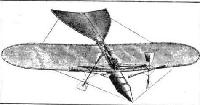A.Andrews. The Flying Machine: Its Evolution through the Ages (Putnam)
If Alphonse Penaud, 1850-1880, was a shooting star, his compatriot Victor Tatin, 1843-1913, was a stayer whose career spanned every phase of man’s final soaring into flight yet could not notch one clear triumph. He was making rubber-driven ornithopters when Penaud was producing his grand design of the amphibious monoplane. By 1879 he had produced a famous model monoplane, though not so graceful or influential as Penaud’s first success, which worked by compressed air. Between 1890 and 1897 he successfully tested a large twin (tandem)-screw monoplane driven by steam. In the next decade he became a Grand Old Man and cheer leader for the French aeroplane constructors in their rivalry with the Wrights. He sponsored an unsuccessful monoplane, the Tatin-De-La-Vaulx, in 1907, and a striking streamlined aircraft, the Tatin-Paulhan Aero-Torpille, in 1911. Victor Tatin, very typical of the keen engineer who never bothered to abandon machinery for a sabbatical year and study actual flight, maintained an enthusiasm for 40 years yet never once saw any of his full-size machines achieve more than a hop before crashing.
Показать полностью
M.Goodall, A.Tagg British Aircraft before the Great War (Schiffer)
Deleted by request of (c)Schiffer Publishing
Tatin
Victor Tatin's name was associated with a variety of advanced aeronautical designs and design projects. Born in 1843, by the time he was 31 he had made his first flying model, a little ornithopter made of feathers and weighing 5 grams. Although this flew, he turned quickly to fixed wing designs, to which he had been introduced by Alphonse Penaud. In 1879 he designed and built a compressed-air powered model, now at the Musee de l'Air, which flew tethered to the center of a circle. The cylindrical tank with conical ends was the fuselage; the engine drove a long connecting rod on each side out along the monoplane wings, driving through cranks 2 tractor propellers. The tail was fan-shaped, like a pigeon's. The design showed Tatin's concern for reducing drag, and influenced the designer's later aeroplanes. Tatin would not be followed in these efforts till Edouard Nieuport in 1909.
In 1881 Tatin designed the propeller of the first electric dirigible, shown at the Paris Electrical Exhibition of that year. The airship was built by Gaston and Albert Tissandier; the motor was a 1-1/2 hp Siemens, and inadequate to the task. The spar-mounted spoon-bladed propeller, however, was to appear often in the next few years on more successful French heavier-than-air machines. And in 1890 Tatin invented an aneroid recording barometer that was to be used as one of the first altimeters in 1891.
The same year, with Professor Charles Richet, later of Breguet-Richet helicopter fame, Tatin designed and tested a large model which resembled Stringfellow's. An angular boat-shaped fuselage carried the steam engine with a propeller at each end of the hull, the rear one turning in an opening in the long flat horizontal surface that became the tail. Trapezoidal wings with a nearly flat airfoil section showed considerable dihedral. Damaged in the same year and then tested over the sea in 1897, it achieved a distance of 140 m before stalling and falling into the water.
(Span: 6.6 m; wing area: 8 sqm; weight: 33 kg; 1-hp steam engine)
In 1904, financed by Henri Deutsch de la Meurthe, he tested a model of a twin-rotor helicopter, at the same time contributing to Santos-Dumont's dirigibles.
In 1906 he designed what was to have been his first full-sized aeroplane, a monoplane sponsored by Jesus Fernando Duro, a member of the Aero Club de France and founder of the equivalent in Spain. Construction began at Maurice Mallet's shops. Unfortunately Duro died from typhoid in August 1906, and the monoplane was left unfinished. It seems likely - but there is nothing left to show what this machine looked like - that some of its elements or basic design appeared again on his next monoplane, this one designed for Count Henri de la Vaulx, and built by Clement-Bayard.
Described as a "soaring plane," it was meant originally to have elliptical dihedral in both the elliptical wing and tailplane; it turned out to have slight dihedral only in the outer wing panels, and neither surface was elliptical in plan, but trapezoidal. The square-sectioned fuselage sat low to the ground, a 50 hp Antoinette set transversely behind the pilot driving 2 Tatin pusher propellers between the tail-booms. The pilot sat well within the fuselage which was tapered at each end.
In his special crash-suit de la Vaulx tested his aeroplane at St Cyr in November 1907. On the 18th he is reported to have taken off after a 50-meter run downwind and stayed aloft for 70 m. In flight, the starboard wing failed: Tatin was known as a skilled clocksmith, not a carpenter: his structure was too weak, although evidently aerodynamically sound.
(Span: 15 m; fuselage length: 6.75 m; overall length: 13.25 m; wing area: 60.4 sqm; gross weight: c 400 kg; 50 hp Antoinette)
Показать полностью





